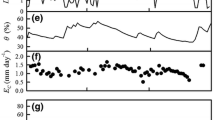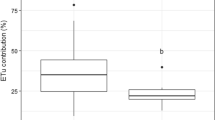Abstract
Estimating stand transpiration of natural forests using traditional methods through up-scaling of sap flux density from sample trees based on stand sapwood area only is difficult because of the complexity of species, ages, and hierarchical structure of natural forests. To improve stand transpiration estimation, we developed an up-scaling method by considering the tree dominance effect based on the assumption that individual tree transpiration is affected by crown dominance and species, in addition to factors previously considered such as meteorological conditions, sapwood area, and soil moisture. In this study, the meteorological factors, soil moisture, and sap flux density of 15 sample trees of different species and dominance in a natural evergreen and deciduous broadleaved mixed forest were simultaneously monitored from March 2012 to February 2014 in the Karst mountain region in southwestern China. After establishing a single tree transpiration model which considers the effects of dominance and species, an up-scaling method was explored to estimate stand transpiration. The results show that the transpiration intensity increased exponentially with increasing tree dominance. The contribution to annual stand transpiration from a few dominant trees (5.4% of trees, 28.2% of basal area) was up to 65.0%. The corresponding contribution was 16.2% from sub-dominant trees (7.6% of trees, 16.2% of basal area) and 22.8% from middle- and lower-layer trees (87.0% of trees, 55.6% of basal area). The variation of individual tree transpiration was mainly (97.9%) explained by tree dominance, but very weakly by tree species. The estimated annual stand transpiration was 300.2 mm when using the newly developed method which considers tree dominance, 52.5 mm (14.9%) lower than the estimation (352.7 mm) of traditional method which considers only the sapwood area effect, and 8.5 mm (2.7%) lower than the estimation (308.6 mm) which considers the effects of both species composition and sapwood area. The main tree characteristics affecting stand transpiration are tree size (sapwood area) and dominance. Consideration of tree dominance will significantly improve stand transpiration estimation and provide a more solid basis for guiding integrated forest–water management at stand scale.








Similar content being viewed by others
References
Barnard HR, Ryan MG (2003) A test of the hydraulic limitation hypothesis in fast-growing Eucalyptus saligna. Plant Cell Environ 26(8):1235–1245
Berry ZC, Looker N, Holwerda F, Gómez Aguilar LR, Ortiz CP, González MT, Asbjornsen H (2017) Why size matters: the interactive influences of tree diameter distribution and sap flow parameters on up-scaled transpiration. Tree Physiol 38(2):263–275
Bond BJ, Kavanagh K (1999) Stomatal behavior of four woody species in relation to leaf-specific hydraulic conductance and threshold water potential. Tree Physiol 19(8):503–510
Bucci SJ, Goldstein G, Meinzer FC, Scholz FG, Franco AC, Bustamante M (2004) Functional convergence in hydraulic architecture and water relations of tropical savanna trees: from leaf to whole plant. Tree Physiol 24(8):891–899
Burgess SSO, Dawson TE (2008) Using branch and basal trunk sap flow measurements to estimate whole-plant water capacitance: a caution. Plant Soil 305(1–2):5–13
Buschmann C (1999) Water vapor and other gases. In: Campbell GS, Norman JM (eds) An introduction to environmental biophysics, 2nd edn. Springer, Berlin, 286 p
Čermák JN, Kučera J, Nadezhdina N (2004) Sap flow measurements with some thermodynamic methods, flow integration within trees and scaling up from sample trees to entire forest stands. Trees 18(5):529–546
Chen DY, Wang YK, Liu SY, Wei XG, Wang X (2014) Response of relative sap flow to meteorological factors under different soil moisture conditions in rainfed jujube (Ziziphus jujuba Mill.) plantations in semiarid Northwest China. Agric Water Manag 136(2):23–33
Chirino E, Bellot J, Sánchez JR (2011) Daily sap flow rate as an indicator of drought avoidance mechanisms in five Mediterranean perennial species in semi-arid southeastern Spain. Trees 25(4):593–606
Chiu CW, Komatsu H, Katayama A, Otsuki K (2016) Scaling-up from tree to stand transpiration for a warm-temperate multi-specific broadleaved forest with a wide variation in stem diameter. J For Res 21(4):161–169
Dalsgaard L, Mikkelsen TN, Bastrup-Birk A (2011) Sap flow for beech (Fagussylvatica L.) in a natural and a managed forest—effect of spatial heterogeneity. J Plant Ecol 4(1–2):23–35
Delzon S, Loustau D (2005) Age-related decline in stand water use: sap flow and transpiration in a pine forest chronosequence. Agric For Meteorol 129(3–4):105–119
Dünisch O, Morais R (2002) Regulation of xylem sap flow in an evergreen, a semi-deciduous, and a deciduous Meliaceae species from the Amazon. Trees 16(6):404–416
Ellsworth DS, Reich PB (1993) Canopy structure and vertical patterns of photosynthesis and related leaf traits in a deciduous forest. Oecologia 96(2):169–178
Ewers BE, Gower S, Bond-Lamberty B, Wang C (2002) Interactive effects of time since fire and tree species composition on stand transpiration and canopy conductance of boreal black spruce forest. Appl Environ Microbiol 61(4):1580–1585
Forrester DI (2015) Transpiration and water-use efficiency in mixed-species forests versus monocultures: effects of tree size, stand density and season. Tree Physiol 35(3):289–304
Gao JG, Zhao P, Shen WJ, Niu JF, Zhu LW, Ni GY (2015) Biophysical limits to responses of water flux to vapor pressure deficit in seven tree species with contrasting land use regimes. Agric For Meteorol 200:258–269
Granier A (1985) A new method of sap flow measurement in tree stems. Ann Sci For 42(2):193–200
Horna V, Schuldt B, Brix S, Leuschner C (2011) Environment and tree size controlling stem sap flux in a perhumid tropical forest of Central Sulawesi, Indonesia. Ann For Sci 68(5):1027–1038
Huang JT, Zhou YX, Yin LH, Wenninger J, Zhang J, Hou GC, Zhang EY, Uhlenbrook S (2015) Climatic controls on sap flow dynamics and used water sources of Salix psammophilain a semi-arid environment in northwest China. Environ Earth Sci 73(1):289–301
Ivanov VY, Hutyra LR, Wofsy SC, Munger JW, Saleska SR, De Oliveira RC, De Camargo PB (2012) Root niche separation can explain avoidance of seasonal drought stress and vulnerability of overstory trees to extended drought in a mature Amazonian forest. Water Resour Res 48(12):935–943
Jiao L (2016) Spatio-temporal variations in stand transpiration of black locust plantations at a re-vegetation catchment in the hilly region of Loess Plateau. University of Chinese Academy of Sciences, Huairou
Jung EY, Otieno D, Lee B, Lim JH, Kang SK, Schmidt MWT, Tenhunen JD (2011) Up-scaling to stand transpiration of an Asian temperate mixed-deciduous forest from single tree sapflow measurements. Plant Ecol 212(3):383–395
Kaufmann MR (1985) Annual transpiration in subalpine forests: large differences among four tree species. For Ecol Manag 13(3):235–246
Kröber W, Bruelheide H (2014) Transpiration and stomatal control: a cross-species study of leaf traits in 39 evergreen and deciduous broadleaved subtropical tree species. Trees 28(3):901–914
Li ZH, Wang YH, Yu PT, Wang YB, Han XS, Cao GX (2015) Variation of sap flow density of Larixprincipis-rupprechtii with dominances and its impact on stand transpiration estimation. For Res 28(1):8–16
Link P, Simonin K, Maness H, Oshun J, Dawson T, Fung I (2014) Species differences in the seasonality of evergreen tree transpiration in a Mediterranean climate: analysis of multiyear, half-hourly sap flow observations. Water Resour Res 50(3):1869–1894
Liu JL, Man XL, Hu Y (2016) Response of tree sap flow of Larixgmelinii with various differentiation classes to multiple environmental factors. For Res 29(5):726–734
Ma C, Guan W, Ye B, Yuan Y, Wan J (2005) Measurement of the sapwood flow of Populusdavidiana with thermal dissipation sap flow proble (TDP). J Agric Univ Hebei 77(2):152–160
Maguire DA, Bennett WS (1996) Patterns in vertical distribution of foliage in young coastal Douglas-fir. Can J For Res 26(11):1991–2005
Motzer T, Munz N, Kãppers M, Schmit D, Anhuf D (2005) Stomatal conductance, transpiration and sap flow of tropical montane rain forest trees in the southern Ecuadorian Andes. Tree Physiol 25(10):1283–1293
Nabeshima E, Hiura T (2008) Size-dependency in hydraulic and photosynthetic properties of three Acer species having different maximum sizes. Ecol Res 23(2):281–288
Otieno D, Li YL, Ou YX, Cheng J, Liu SZ, Tang XL, Zhang QM, Jung EY, Zhang DQ, Tenhunen J (2014) Stand characteristics and water use at two elevations in a sub-tropical evergreen forest in southern China. Agric For Meteorol 194(3):155–166
Pfautsc S, Bleby TM, Rennenberg H, Adams MA (2010) Sap flow measurements reveal influence of temperature and stand structure on water use of Eucalyptus regnans forests. For Ecol Manag 259(6):1190–1199
Roberts S, Vertessy R, Grayson R (2001) Transpiration from Eucalyptus sieberi (L. Johnson) forests of different age. For Ecol Manag 143(1):153–161
Ryan MG, Bond BJ, Law BE, Hubbard RM, Woodruff D, Cienciala E, Kucera J (2000) Transpiration and whole-tree conductance in ponderosa pine trees of different heights. Oecol 124(4):553–560
Schmidt U, Thoni H, Kaupenjohann M (2000) Using a boundary line approach to analyze N2O flux data from agricultural soils. Nutr Cycl Agroecosyst 57(2):119–129
Střelcová K, Matejka F, Minďáš J (2002) Estimation of beech tree transpiration in relation to their social status in forest stand. J For Sci 48(3):130–140
Trouvé R, Bontemps JD, Seynave I, Collet C, Lebourgeois F (2016) Stand density, tree social status and water stress influence allocation in height and diameter growth of Quercus petraea (Liebl.). Tree Physiol 35(10):1035–1046
Tsuruta K, Komatsu H, Kume T, Shinohara Y, Otsuki K (2015) Canopy transpiration in two Japanese cypress forests with contrasting structures. J For Res 20(5):464–474
Vertessy RA, Benyon RG, O’Sullivan SK, Gribben PR (1995) Relationships between stem diameter, sapwood area, leaf area and transpiration in a young Mountain Ash Forest. Tree Physiol 15(9):559–567
Wan YF, Yu PT, Liu XD, Wang SL, Wang YH, Xiong W (2017) Variation in sap flow density among levels of tree dominance in Picea crassifolia in the Qilian Mountains. Acta Ecol Sin 37(9):3106–3114
Whitley R, Taylor D, Macinnis-Ng C, Zeppel M, Yunusa I, O’Grady A, Frocnd R, Mcdlyn B, Eamus D (2013) Developing an empirical model of canopy water flux describing the common response of transpiration to solar radiation and VPD across five contrasting woodlands and forests. Hydrol Proces 27(8):1133–1146
Wullschleger SD, Hanson PJ, Todd DE (2001) Transpiration from a multi-species deciduous forest as estimated by xylem sap flow techniques. For Ecol Manag 143(1):205–213
Xiong W, Oren R, Wang YH, Yu PT, Liu HL, Cao GX, Xu LH, Wang YN, Zuo HJ (2015) Heterogeneity of competition at decameter scale: patches of high canopy leaf area in a shade-intolerant larch stand transpire less yet are more sensitive to drought. Tree Physiol 35(5):470–484
Zeppel MJB, Yunusa IAM, Eamus D (2010) Daily, seasonal and annual patterns of transpiration from a stand of remnant vegetation dominated by a coniferous Callitris species and a broad-leaved Eucalyptus species. Physiol Plant 127(3):413–422
Author information
Authors and Affiliations
Corresponding author
Additional information
Publisher's Note
Springer Nature remains neutral with regard to jurisdictional claims in published maps and institutional affiliations.
Project funding: This study was supported by the Regional Fund of the National Natural Science Foundation of China (31760240) and the Guizhou Provincial Basic Research Program (Qiankehe JZ [2014]200212).
The online version is available at http://www.springerlink.com
Corresponding editor: Yanbo Hu.
Rights and permissions
About this article
Cite this article
Liu, Y., Ding, F., Shu, D. et al. Dominance-caused differences in transpiration of trees in a Karst broadleaved mixed forest. J. For. Res. 31, 2083–2095 (2020). https://doi.org/10.1007/s11676-019-01037-1
Received:
Accepted:
Published:
Issue Date:
DOI: https://doi.org/10.1007/s11676-019-01037-1




